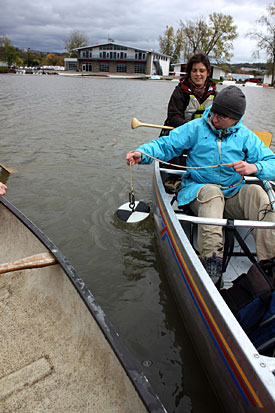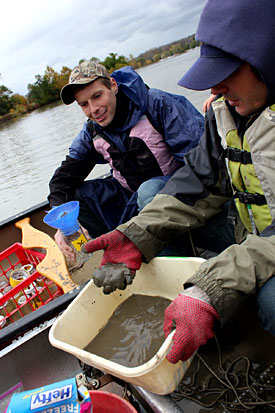To dredge or not to dredge: Class analyzes inlet options
By Craig Cramer


Every fall, students in Restoration Ecology (HORT 4400) take on a real-world project in the local community, working together to gather data, analyze the issues and report their findings.
This year, they're looking at plans to dredge Cayuga Inlet, where an estimated 667,000 cubic yards of sediment have accumulated in the flood control channel at the southern end of Cayuga Lake. The area was last dredged in the 1980s, and the increasingly shallow water plays havoc with boat navigation and reduces the channel's capacity to carry flood water.
"The city of Ithaca has been developing a dredging strategy for five years. Dredging is a daunting task that could take 10 to 60 years, and it's not going to be cheap," says Tom Whitlow, associate professor of horticulture and the course's instructor.
But Whitlow's class is in a unique position to help analyze the options. "We're not as constrained by politics as local governments, NGOs and other stakeholders," he says. "The students bring a lot of energy and creativity. They ask questions and propose options that others might not consider."
The class also has access to equipment and expertise on campus to help them gather and analyze data. For one lab session, students went through the inlet in boats and canoes to map the depth of sediment using sonar, take sediment samples for physical and chemical analysis, and measure how far light penetrates into the water to predict aquatic plant habitat. This year's project has been complicated by the August discovery of Hydrilla verticillata, an invasive aquatic weed, at several locations around the inlet. Any options suggested by the class can't increase the weed's spread, Whitlow points out. The class is conducting tests to see how drying out the plant affects its ability to survive.
The central issue is what to do with the sediment after it's dredged. "The farther you move it, the more expensive it gets," says Whitlow. "But from the perspective of restoration ecology, we're not viewing the sediment as a waste product. We're treating it as a resource that can be used to maintain or improve ecosystem services locally."
For example, one option might include using the dredged sediment to create habitat for wildlife and migratory birds in the increasingly developed areas south of the inlet.
Other class activities this semester included meeting local governmental and environmental leaders on a boat tour of the inlet, exploring sediment sources in watersheds flowing to the inlet and analyzing sites where sediment from previous dredging was deposited.
The students also took a field trip to the Chesapeake Bay to visit an artificial island created for wildlife habitat from sediment dredged from the Baltimore shipping channel and to see how watersheds are managed in highly developed areas in suburban Washington, D.C.
The class will present its findings at the Tompkins County Public Library Dec. 1.
"It will be interesting to see how the class translates all the information, considering the history, the politics and what their own data show," says Whitlow. "As future planners, resource managers and landscape architects, I want them to have a hands-on appreciation of the mechanics of analyzing complex problems. And this project has certainly done that."
Craig Cramer is a communications specialist in horticulture.
Media Contact
Get Cornell news delivered right to your inbox.
Subscribe